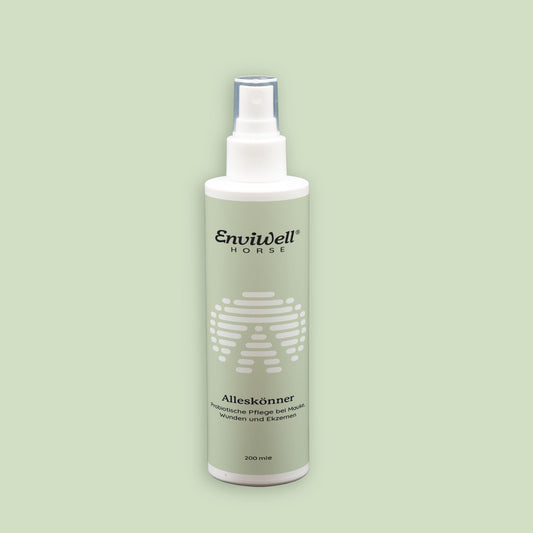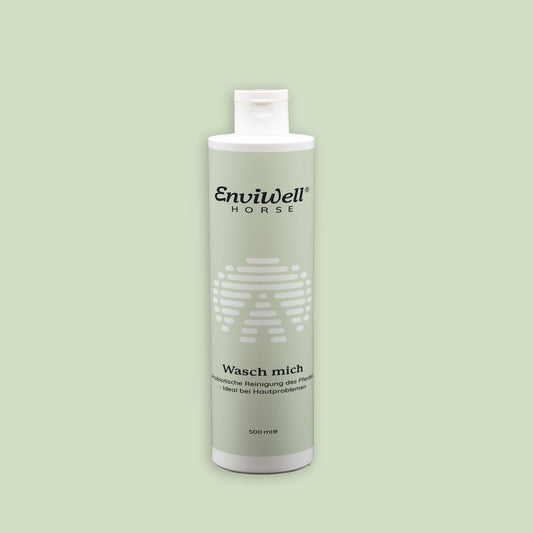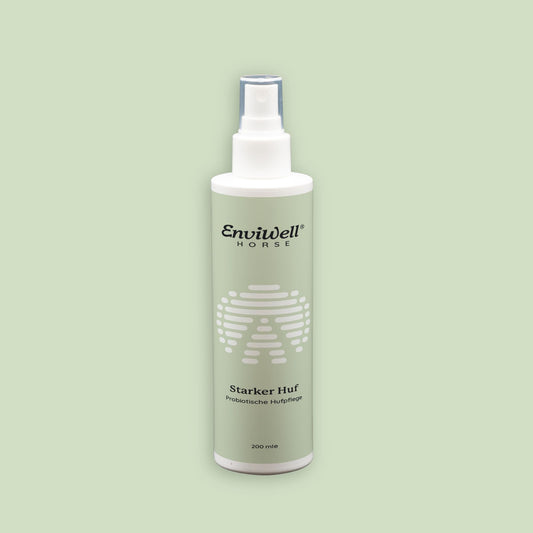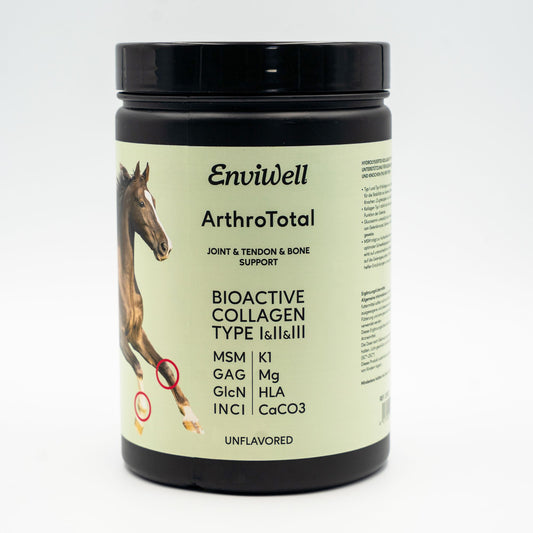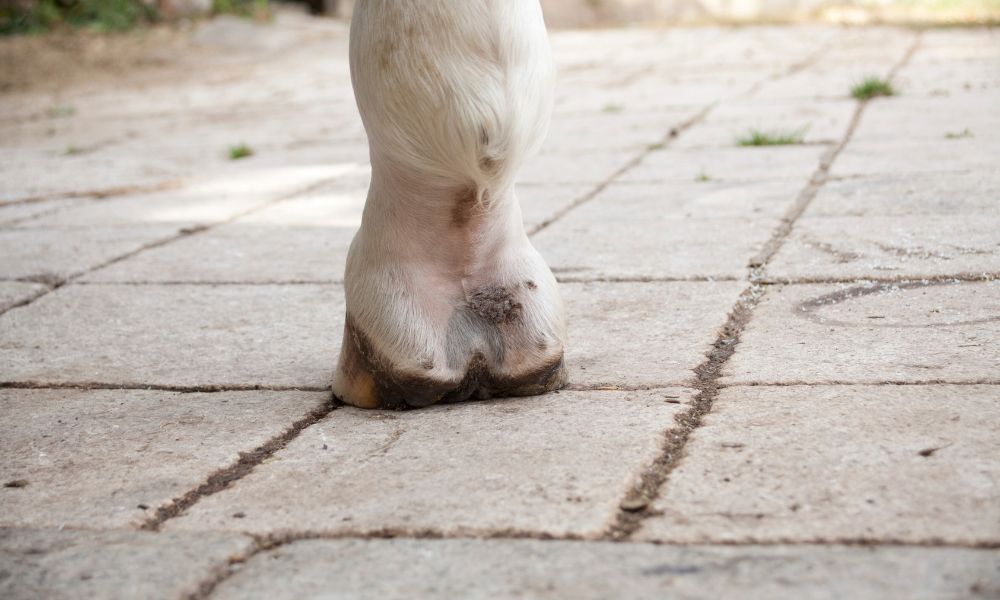
Mud fever on the horse: Symptoms and treatment
Alexander DurbanMud fever on horses is an inflammatory skin disease that primarily occurs in the pasterns of your horse and is aggravated by moisture, dirt, and a weakened immune system. Typical symptoms such as redness, crusts, and wounds can impair your horse's well-being. With the right care and natural products, you can effectively treat and prevent mud fever.
What is mud fever on horses?
Mud fever is an inflammatory skin disease that primarily affects horses in the sensitive pastern area. It is caused by the interaction of external influences such as moisture, dirt, or poor hygiene, and internal factors such as a weakened immune system. This disease is promoted by microorganisms such as bacteria and fungi, which, under certain conditions, overcome the skin barrier and trigger inflammation. The visible symptoms range from redness and swelling to crusting and open, painful wounds.
Nature shows us how effectively microorganisms can work in our ecosystem, and this is precisely where the key to combating mud fever lies. Advances in microbiology allow us to develop natural, environmentally friendly solutions that restore the equine skin environment and naturally support the horse's immune system.
Early treatment and consistent care can not only alleviate the symptoms but also specifically combat the causes. A sustainable approach that relies on high-quality, environmentally friendly products minimizes the risk of recurrence while simultaneously contributing to the horse's well-being. This not only treats mud fever, but also promotes the animal's long-term health and quality of life.

Frequently affected areas with mud fever
Mud fever primarily occurs in the horse's sensitive fetlock area , an area particularly vulnerable to harmful environmental influences due to its proximity to the ground. Moisture, mud, and dirt easily accumulate in this zone, creating a moist, oxygen-poor environment—perfect conditions for microorganisms such as bacteria and fungi that can attack the skin. These external stimuli weaken the skin's natural barrier function and promote inflammation, which manifests as redness, crusts, and painful wounds.
The hind legs are also frequently affected, especially in horses that stand on wet or unhygienic surfaces . Regular movement and weight-bearing stress on the legs requires special attention, as the skin in these areas is already under considerable strain.
The most common causes of mud fever in horses
Mud fever is a complex condition that can be triggered by a combination of external and internal factors. Understanding the causes is essential for targeted treatment and long-term prevention. Below, we highlight the key causes:
Environmental factors: moisture and dirt
Damp and unhygienic environments are one of the main causes of mud fever. Horses kept in muddy paddocks, wet pastures, or poorly mucked stables are particularly at risk. Humidity combined with dirt creates an ideal environment for bacteria and fungi to attack the delicate skin in the fetlock area. Prolonged wetness softens the skin and makes it vulnerable to micro-tears, through which microorganisms can more easily penetrate.
The solution lies in creating a habitat for the horse that is as dry and clean as possible . Regular floor maintenance and targeted measures such as providing dry lying areas can significantly reduce the risk. Such preventative approaches not only protect the horse's health but also minimize the ecological footprint through efficient use of resources.
Care mistakes: Insufficient cleaning and wrong products
Another factor contributing to the occurrence of mud fever is inadequate or incorrect care of the horse's legs . A lack of cleaning of the pasterns allows dirt, mud, and bacteria to remain on the skin and cause inflammation. Equally problematic is the use of unsuitable care products, which either dry out the skin or attack its natural protective barrier.
A sustainable and responsible approach relies on regular, gentle cleansing and the use of natural, skin-friendly care products . These should support the skin without irritating it and, at the same time, be based on environmentally friendly ingredients that do not harm animals or the environment.
Predisposition: Genetic predisposition and weakened immune system
Some horse breeds, such as cold-blooded horses or horses with dense mane, have a genetic predisposition that increases the risk of mud fever. The dense mane impedes ventilation of the skin and can trap moisture, which promotes the development of skin irritations. In addition, a weakened immune system, for example, due to stress, poor nutrition, or other illnesses, can lower a horse's defenses and make it more susceptible to mud fever.
A holistic approach to the horse's health is crucial here. A balanced diet that strengthens the immune system and targeted measures to promote general well-being can play a crucial role in minimizing the risk. The key lies in a natural and preventative approach that respects the individual needs of the animal.
All-rounder - Probiotic care for mud fever, wounds and eczema
- Ideal for the treatment of mud fever, wounds, eczema and parasites
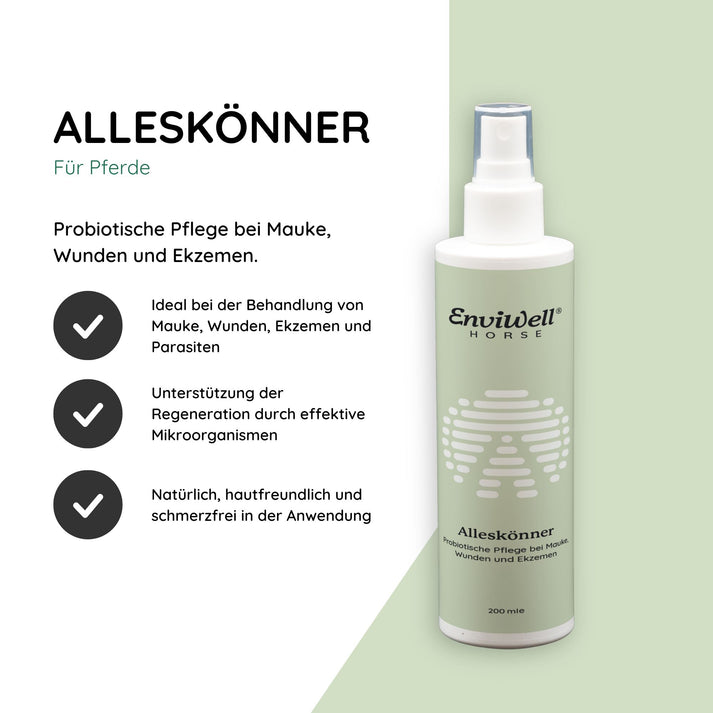
Typical symptoms of mud fever in horses
The symptoms of mud fever can vary depending on the severity and progression of the disease . Early detection is essential for rapid response and to ensure the horse's well-being. The most important visual and behavioral signs of mud fever are described below.
Visible signs: crusting, skin redness and swelling
One of the first and most common visible symptoms of mud fever is the formation of crusts in the pastern . These crusts are caused by inflammatory processes in which the skin is damaged by bacteria or fungi. This is often accompanied by reddening of the skin, indicating irritated and inflamed areas. In more severe cases, swelling may occur, affecting not only the affected skin but also the underlying tissue.
The scabs are often hard and can be painful to the touch. In advanced stages, weeping wounds may develop, further complicating healing and increasing the risk of secondary infection. Regular examination of the fetlock joints, especially after exposure to damp or muddy environments, is crucial for early detection of these signs.
Horse behavior: lameness and sensitivity to pain
In addition to the visible symptoms, the horse's behavior often also provides clear evidence of mud fever. Many horses react sensitively when the affected areas are touched or cleaned. In more severe cases, the horse may become lame, as the inflamed areas cause pain when moving. The horse may also become less active or unwilling to exercise, especially if the condition is left untreated. Such behavioral changes are an important indicator that mud fever is already significantly affecting the animal's well-being.
"My horse, Bel, keeps getting mud fever on her hind legs—even now during the mud season. That's why I've incorporated this "all-rounder" into our grooming routine. It seems to me that it healed faster this time. I also find the spray great for wound care. Bel doesn't like it when I treat a wound with ointment, but the spray was very easy to use. This makes the product last a really long time."
– Lisa, product tester
To the product testThe correct treatment of mud fever in horses
Treating mud fever requires a rapid and systematic approach to alleviate the symptoms and combat the causes of the disease. Proper care and the use of suitable products, such as the " all-rounder" from EnviWell , play a crucial role.
First steps: Clean and keep the affected area dry
Once mud fever is detected, the affected area should be thoroughly cleansed. It's important to use gentle, pH-neutral products to avoid further irritation. Excess dirt and crusts should be carefully removed without damaging the inflamed skin.
After cleaning, it's important to dry the area thoroughly, as moisture promotes the growth of microorganisms. Use soft, clean towels and be careful not to irritate the skin by rubbing. A clean, dry environment creates the foundation for healing and prevents symptoms from worsening.
Suitable products: Disinfectant solutions and mud fever ointments
EnviWell's "all-rounder" is ideal for treating mud fever. The probiotic care formula with effective microorganisms promotes skin regeneration, accelerates wound healing, and ensures gentle, painless application.
This all-rounder is also ideal for prevention : Regular use strengthens the skin's natural microbiome, preventing skin problems and making the skin more resistant to parasites and external influences. The product is skin-friendly and suitable even for animals with sensitive skin – daily use is possible without any problems. With this all-rounder, you can offer your pet effective and gentle care that works naturally and sustainably.
All-rounder - Probiotic care for mud fever, wounds and eczema
- Ideal for the treatment of mud fever, wounds, eczema and parasites

When should a veterinarian be consulted?
In some cases, grooming alone is not enough to treat mud fever. A veterinarian should be consulted if:
- symptoms worsen despite regular treatment,
- the affected skin is wet or very swollen,
- the horse shows signs of lameness or severe discomfort.
Your veterinarian may recommend additional measures, such as prescribing antibiotic or antifungal medications . In advanced cases, a professional assessment is crucial to prevent further complications and ensure the best possible treatment.

Prevention of mud fever in horses
Preventing mud fever is crucial to avoid this common skin disease in the long term and promote your horse's health. With the right measures, you can not only prevent the development of mud fever but also sustainably improve your horse's well-being.
Optimal stable conditions: dry bedding and clean floors
One of the most important measures for preventing mud fever is creating a dry and hygienic stable environment . Damp and dirty floors promote the development of skin irritations and microorganisms that can trigger mud fever. Dry, regularly changed bedding and well-ventilated stable areas significantly reduce the risk. Care should also be taken to avoid standing water and excessive mud in paddocks and pastures.
Regular care: Daily cleaning of the legs
Daily leg care is essential to prevent mud fever. Dirt, moisture, and bacteria must be removed to keep the skin healthy. Alleskönner effectively supports this: With its probiotic care formula, it strengthens the natural skin microbiome and protects the skin from harmful influences . Regular use of Alleskönner not only thoroughly cleanses your horse's legs but also gently cares for them. Its natural ingredients promote skin resilience and help prevent skin problems like mud fever from occurring in the first place.
Strengthening the immune system: balanced feeding is the key
A strong immune system is the best protection against skin diseases like mud fever . A balanced diet containing all the essential nutrients, vitamins, and minerals contributes significantly to your horse's overall health. Zinc and biotin, in particular, are essential for skin health and should be included in sufficient quantities in the feed. Natural supplements can also help provide targeted support for the immune system.
All-rounder – your reliable partner against mud fever
Mud fever can be a challenge for both horse and owner, but with the right care and the right products, the problem can be effectively addressed. Alleskönner offers an innovative and natural solution specially developed to gently regenerate your horse's skin and heal wounds quickly. Thanks to its probiotic care formula, Alleskönner not only protects against mud fever but also strengthens the natural skin microbiome, making the skin more resistant to external influences and parasites. Whether for targeted treatment or preventative care, Alleskönner impresses with its skin-friendly, gentle application and lasting effect.

